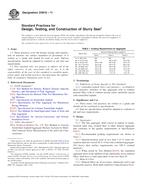1.1 This practice covers procedures commonly used in the paint industry to formulate paints and coating materials. It describes procedures for calculating formulation values for weight solids, volume solids, solvent content, volatile organic compound (VOC) content, hazardous air pollutant (HAP) content, and density of liquid paints and coatings. These values are calculated from basic formulation data. These calculations may be related to either as-supplied (unreduced) or as-applied (reduced) coating materials, including multicomponent types.
1.2 These calculated, formulation-based values may or may not be acceptable for VOC regulatory purposes, depending on the specific wording of the applicable regulation. Some regulations require analysis of the coating. Some rules allow the use of formulation data, however, some adjustments may be needed to the values calculated in this practice before they are used for regulatory purposes (see 4.3).
1.3 For purposes of this practice, it is assumed that volatile components evaporate and the materials that remain are identified as coating solids. For example, solvents are normally used to adjust viscosity for application and appearance of the coating. Other liquid materials, such as plasticizers, reactive diluents, etc., that are expected to be retained in the dried film to affect the final physical properties should be classified as part of the coating solids. Standards such as Test Methods D2369, D4758, D5403 and Guide D2832 may be used to determine volatile or nonvolatile content of specific components. For purposes of this practice it is assumed that the blended formulation behaves as an ideal solution with no volume change on mixing (see 6.2).
1.4 Volatile by-products of cross-linking reactions (cure volatiles) are not considered in these calculations since the object of this practice is to define paint physical constants based on formulation information. Variations in raw materials, variations in the production processes, test methods, and test method accuracy are not taken into account in these calculations.
1.5 The values stated in inch-pound units are to be regarded as standard. The values given in parentheses are mathematical conversions to SI units that are provided for information only and are not considered standard. However, they may be readily converted into SI units, if required by the user (for example, see Note 4).
Product Details
- Published:
- 02/01/2010
- Number of Pages:
- 6
- File Size:
- 1 file , 100 KB


